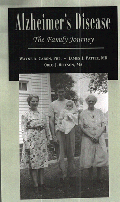

| Alzheimer's: The Family Journey | |
 Wayne A. Caron, Ph.D. James J. Pattee, M.D. Orlo J. Otteson, M.A. Table of Contents Preface Acknowledgments CHAPTER ONE Alzheimer's Disease: Impact On Family This chapter describes the biological, cognitive and behavioral features of Alzheimer's disease. It identifies family care issues and dilemmas, and it introduces a phase model that can help families address care challenges. CHAPTER TWO The Family And The Family System This chapter defines the family and describes the unique features of family life. It discusses the dynamics of the family system and the need for Alzheimer's families to maintain an adaptive, learning family system. CHAPTER THREE Alzheimer's Disease: Causes And Effects This chapter describes Alzheimer's disease and defines its various stages. It discusses the nature of dementia (the "Alzheimer's world") and its effects on afflicted individuals. CHAPTER FOUR Alzheimer's Disease: A Family Illness This chapter discusses the ways in which Alzheimer's disease constitutes a "family illness" that pervades and permeates family life. It describes some ways in which the disease invades and disorganizes family life, and it discusses some ways in which the family can meet those challenges. CHAPTER FIVE Phase One: The Prediagnosis Phase This chapter describes the uncertainty surrounding the prediagnosis phase. And it discusses some ways in which family members can move toward greater certainty – while maintaining family stability. CHAPTER SIX Phase Two: The Diagnosis Phase This chapter describes the diagnosis process and the family's role in that process. It discusses some ways in which family members can obtain a diagnosis and "bring it in" to family life. CHAPTER SEVEN Phase Three: The Role Change Phase This chapter describes the functional decline of the elder, and it discusses some ways in which family members can address the role changes that accompany this decline. CHAPTER EIGHT Phase Four: The Chronic Care Phase This chapter describes the physical, psychological, and emotional sources of caregiver strain. And it discusses some ways in which the family can support caregivers through maintaining the vitality of family life. CHAPTER NINE Phase Five: The Shared Care Phase This chapter describes the benefits of outside help, and it discusses some ways in which the family can assess its need for outside help. It describes the process for obtaining help and for establishing a partnership with the health care system. CHAPTER TEN Phase Six: The Nursing Home Phase This chapter describes the benefits of nursing home care, and it discusses some ways in which family members can approach placement decisions. It defines the family's role in nursing home care, and it discusses the process for establishing a relationship with nursing home professionals. CHAPTER ELEVEN Phase Seven: The End Of Journey Phase This chapter discusses the end of life challenges, and it describes some ways in which family members can ensure a "good death" for the elder – and find effective closure for themselves. CHAPTER TWELVE Understanding Behavior Problems This chapter describes an approach to understanding behavior problems, and it discusses some strategies for relieving family frustration and turmoil. The chapter describes the differences between cognitive impairments and behavior problems. It discusses the nature and function of expectations in understanding problem behaviors. And it describes a step-by-step approach for organizing helpful responses to problem behaviors. CHAPTER THIRTEEN Teaching Stories The "teaching stories" in this chapter are intended to help family members explore the material that has been discussed in the preceding chapters. The stories are intended to help family members see the ways in which various concepts apply to "real life" circumstances and problems. They are designed to help family members step back and see new options – new opportunities for addressing care challenges. |